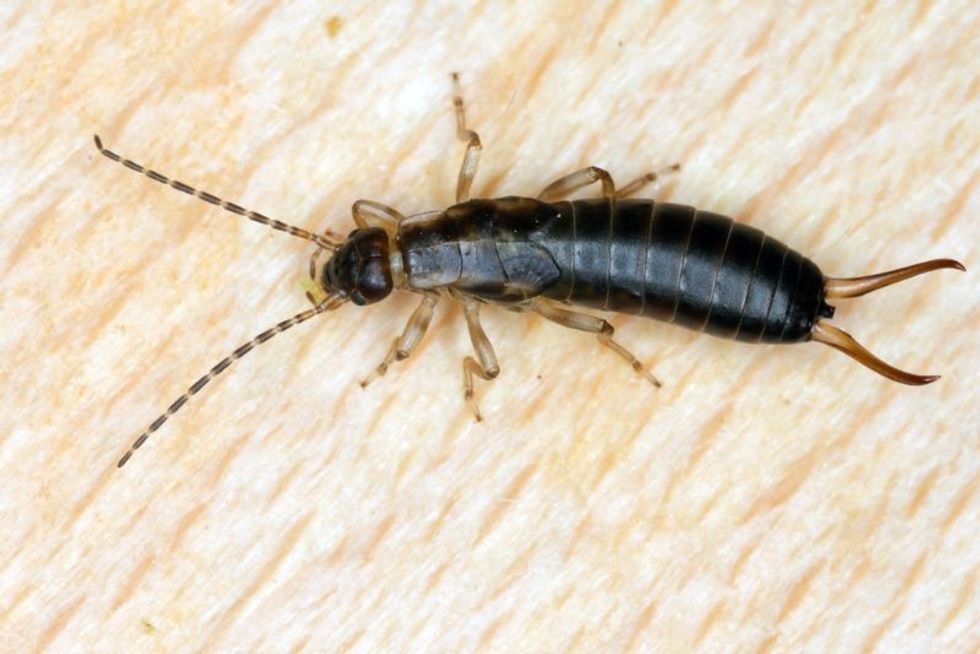About 22 species of earwigs are found in the US, and you will mostly find the common earwig or the European earwig (Forficula auricularia) everywhere in your garden.
Although earwigs aren't really that creepy, the name sure does sound bizarre. The name earwig means ear creature or ear wiggler, which originated from the stories that said it crawls into people's ears while they are sleeping to lay eggs.
The earwigs are native to Europe, Africa, and western Asia. The first common earwig or the European earwig (Forficula auricularia) outbreak was reported in 1911 in Rhode Island, North America. The earwigs may dwell in plants like potatoes, lettuce, corn, and herbs; earwigs usually live in damp areas during the daytime.
Here is some fascinating information about earwigs. If you enjoy reading our article, you could also read about dragonfly larvae and insects larva.
What are earwig larvae called?
Around 20 earwig species are found in North America, but the most famous are common earwigs or European earwigs (Forficula auricularia). The life cycle of the North American and the European earwig has some similarities and some dissimilarities.
All earwigs undergo the process of metamorphosis. Metamorphosis is the process of developing from an egg to becoming an adult insect.
There are three stages involved in the earwig life cycle- egg, nymphs, and adult.
The nymphs or the juveniles are somewhat similar to the adults. They still do undergo some metamorphosis. Other insect species undergo complete metamorphosis, and the stages are egg, larva, pupa, and adult.
Since the earwigs undergo the simple metamorphosis process, the earwigs lay eggs, these eggs hatch, and the first stage appears. As the earwigs start growing to form the nymph, it sheds its shell. The next stage appears as the shell is shed; here, the body is soft and whitish.
The shell gradually hardens and becomes dark brown. This process of hardening and then darkening is called sclerotization. The hardened shell or the skin is called sclerotized.
So, the earwigs go through several instar stages from first to second and so on. They develop from an egg to become adults. With a supply of adequate food, they can reproduce in the summer months and become full adults by the end of the season.
So how to identify the earwig? They are one of the common house garden pests, and everyone knows about their appearance. Most people aren't fond of them and get irritated seeing these pests in their house garden. The adult earwigs have hardened shells and are shiny brownish-red.
The wings are short and leathery; there are large pincers at the end of the body. The earwig's wings look almost similar to that of other insects and pests. You will find the earwig larvae in water or where it is moist.
The male earwigs' forceps are curved and large, and the females have a small and straight pair. The male forceps are usually used at the time of mating and to get rid of predators.
The eggs of the earwigs are found in clutches in the soil; they are white to brown. The nymphs look somewhat similar to the adults; the nymphs have a light brown body.
Pest control of these unwanted house or garden bugs is essential. Methods of removing the earwigs are many. Search for ways to get rid of them. You can use organic methods, chemical pesticides, and spraying with insecticides. Otherwise, make a call to a pest control professional.
Always keep your garden clean by removing the decaying matter, unwanted plants, and damaged fruits since the earwigs feed on them. Eliminate all the unwanted plants from your yard. The earwigs usually live in the damp and moist places near the house. You could eliminate the earwigs by trapping and physically removing them.
Since earwigs go through simple metamorphosis, the earwig's larvae are known as nymphs. For example, there are many stages before the pupa stage or the end of the metamorphosis after the egg hatches.
Earwig Larvae Stages
There are many species of earwigs, and they are found in large numbers. The earwigs' species all have almost similar life cycles and body structures. Earwigs struggle to live in cold climatic conditions, and so they are found in warm climates.
The female earwigs lay their eggs in protected areas such as under wet plant leaves or in crevices where it is damp, and moisture is present.
Like many other insects, the earwigs undergo the process of metamorphosis. Their body develops throughout the life cycle to finally become an adult.
Metamorphosis is the process of changing from one form (immature) to another (adult). The earwigs complete the process of metamorphosis with three stages: egg, nymph, and adult.
The metamorphosis process of earwigs is known as simple or incomplete metamorphosis since they lack the larva and pupa stages of growth, and the larvae and adults look somewhat similar. So, it means the nymph is the larvae.
The mating season of the earwigs starts in the early winter months. The female earwigs carry their eggs until they find a protected area to hide and lay their eggs.
The female earwig usually hides their eggs in areas where moisture is present under the wet plant leaves or crevices. You will find white eggs in the soil, usually in the late winter season.
Molting means shedding old skin. The nymphs will experience four to six molting sessions before they become fully mature. They attain new features to become fully functional adult earwigs with wings, pincers, antennas, and shells as they molt. The pincer comes from the tip of the abdomen.
Once the earwig undergoes the last molting stage, it finally becomes a fully functional adult. Adult earwigs can eat, hunt, and live on their own. They are fully winged, have pincers, antennae, shells, and are sexually active.
What do earwig larvae eat?

Earwigs are small insects and belong to the order Dermaptera. The earwigs are nocturnal creatures; they hide in moist, damp, and dark areas during the day.
Their body is dark brownish; they have a pair of wings and a pair of pincers known as cerci at the end of the abdomen. However, although the earwigs have wings, they don't use them to fly.
The earwigs have a diverse diet and have different sources of food. Since they are nocturnal insects, the earwigs go out at night in search of food and feed on small insects like fleas, mites, and eggs of insects. The earwigs also feed on the dead organic matter of animals.
You will also find earwigs in a flower, fruit, corn, or vegetable garden. This insect loves to eat flower petals, flower buds, and seedlings as well. Dahlias, carnations, butterfly bush, sunflowers, zinnias, and hollyhocks are typically significantly damaged by this insect.
They typically sink into the ground near the plants in your yard. Crops that earwigs pests eat are peaches, pears, strawberries, cucumber, cabbage, chard, lettuce, potatoes, pea, and beets. However, their exact choice of food will depend on the location.
How To Get Rid Of Earwig Larvae
Earwigs are common insects, and they look frighteningly unpleasant. Once you set traps for them, keeping them from coming indoors and into your home foundation is essential.
As the earwigs sometimes wind up coming indoors, it is essential to get rid of them permanently by setting traps to catch them before entering your home foundation. When the pest populations get out of control, they will do significant damage to your garden and yard.
Don't worry; there are many ways to eliminate and control the pest population. Here are a few of your options to get rid of earwigs:
- Remove all the debris and mulch
- Make a soap and water spray
- Make an oil and soy sauce trap
- Use an alcohol and water mixture
- Make a light trap
- Apply boric acid powder.
If you cannot control the situation by yourself, call a pest control professional.
The University of Florida, University of Nebraska-Lincoln, University of Minnesota are all studying pest control methods.
Earwigs can't hurt you; their forceps or pincers will grasp your finger but are not dangerous and won't sting you. The pincers do not have venom, so they are not poisonous, unlike insects like mosquitoes and bed bugs that hurt people by biting.
Here at Kidadl, we have carefully created lots of interesting family-friendly facts for everyone to enjoy! If you liked our suggestions for earwig larvae, then why not take a look at cockroach larvae or earwig facts.









